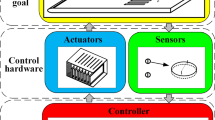Abstract
The reduction in the drag and lift forces on a square cylinder is obtained by attaching an extended solid (thorn) with it positioned at the front stagnation point and at the rear stagnation point separately at low Reynolds number, Re = 40, 100 and 180. The effect of variation of thorn length (l′ = 0.2, 0.4 and 0.6) and inclination angle (θ = 5°, 10°, 15° and 20°) on the drag, lift and this effect is forecasted by the ANN (artificial neural network) and GEP (gene expression programming). The required input and output data to train the ANN and GEP models have been taken from the available published results of the present authors (Dey and Das in Eng Sci Technol 18:758–768 [2015]; in Ain Shams Eng J 6:929–938 [2015]). It is found that the drag and lift are minimized by 16 and 46 % for Re = 100, respectively, and 22 and 60 % for Re = 180 compared to a square model. It has been perceived that both the prediction tools (ANN and GEP) can forecast the aerodynamic behavior correctly and quickly within the given range of the training data than simulation, which takes much longer time to complete the computation. It is further observed that the GEP model is much efficient than the ANN model.















Similar content being viewed by others
References
Bearman P (1965) Investigation of the flow behind a two-dimensional model with a blunt trailing edge and fitted with splitter plates. J Fluid Mech 21:241–255
Bearman P (1967) The effect of base bleed on the flow behind a two-dimensional model with a blunt trailing edge(Base bleed effects on flow behind two-dimensional model with blunt trailing edge, measuring base pressure, shedding frequency and vortex formation). Aeronaut Q 18:207–224
Darekar R, Sherwin S (2001) Flow past a bluff body with a wavy stagnation face. J Fluids Struct 15:587–596
Darekar RM, Sherwin SJ (2001) Flow past a square-section cylinder with a wavy stagnation face. J Fluid Mech 426:263–295
Dey P, Das A (2015) Numerical analysis of drag and lift reduction of square cylinder. Eng Sci Technol 18:758–768
Dey P, Das A (2015) Steady flow over triangular extended solid attached with square cylinder—a method to reduce drag. Ain Shams Eng J 6:929–938
Dey P, Sarkar A, Das AK (2015) Development of GEP and ANN model to predict the unsteady forced convection over a cylinder. Neural Comput Appl. doi:10.1007/s00521-00015-02023-00528
Dey P, Sarkar A, Das AK (2015) Prediction of unsteady mixed convection over circular cylinder in the presence of nanofluid—a comparative study of ANN and GEP. J Naval Archit Mar Eng 12:57–71
Ferreira C (2001) Gene expression programming: a new adaptive algorithm for solving problems. Complex Syst 13:87–129
Ferreira C (2002) Gene expression programming in problem solving. Soft computing and industry. Springer, Berlin, pp 635–653
Kurtulus DF (2009) Ability to forecast unsteady aerodynamic forces of flapping airfoils by artificial neural network. Neural Comput Appl 18:359–368
Lee S-J, Lee S-I, Park C-W (2004) Reducing the drag on a circular cylinder by upstream installation of a small control rod. Fluid Dyn Res 34:233–250
Mahbub Alam M, Sakamoto H, Zhou Y (2006) Effect of a T-shaped plate on reduction in fluid forces on two tandem cylinders in a cross-flow. J Wind Eng Ind Aerodyn 94:525–551
Malekzadeh S, Sohankar A (2012) Reduction of fluid forces and heat transfer on a square cylinder in a laminar flow regime using a control plate. Int J Heat Fluid Flow 34:15–27
Quintavalla SJ, Angilella AJ, Smits AJ (2013) Drag reduction on grooved cylinders in the critical Reynolds number regime. Exp Thermal Fluid Sci 48:15–18
Roshko A (2012) On the wake and drag of bluff bodies. J Aeronaut Sci 22
Sivanandam S, Deepa S (2006) Introduction to neural networks using Matlab 6.0. Tata McGraw-Hill Education
Sreekanth S, Ramaswamy H, Sablani S, Prasher S (1999) A neural network approach for evaluation of surface heat transfer coefficient. J Food Process Preserv 23:329–348
Zhou L, Cheng M, Hung K (2005) Suppression of fluid force on a square cylinder by flow control. J Fluids Struct 21:151–167
Author information
Authors and Affiliations
Corresponding author
Rights and permissions
About this article
Cite this article
Dey, P., Sarkar, A. & Das, A.K. Capability to predict the steady and unsteady reduced aerodynamic forces on a square cylinder by ANN and GEP. Neural Comput & Applic 28, 1933–1945 (2017). https://doi.org/10.1007/s00521-016-2186-y
Received:
Accepted:
Published:
Issue Date:
DOI: https://doi.org/10.1007/s00521-016-2186-y




